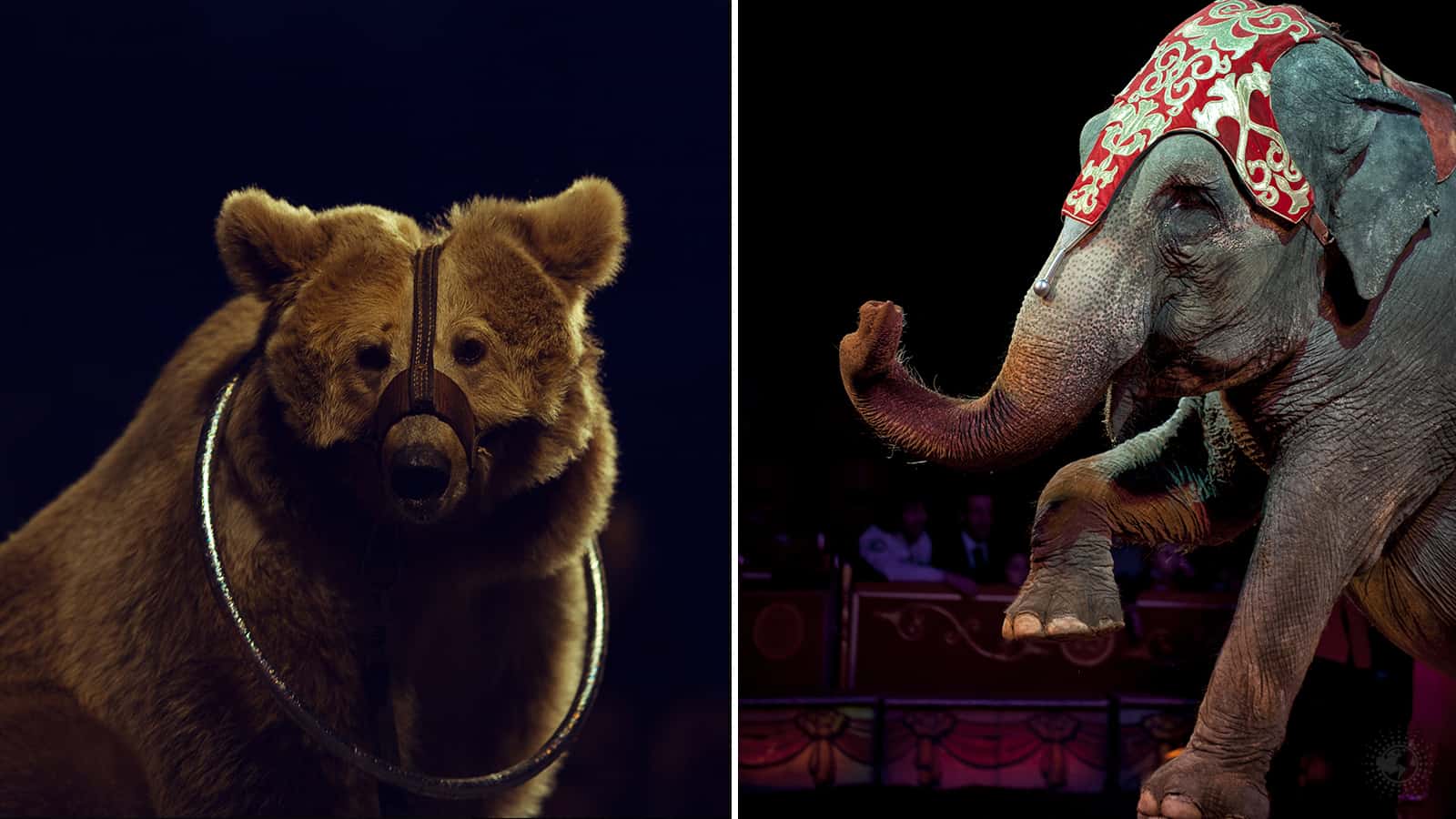In September of 2020, France gave an official nod to ban circus animals. This comes on the heels of a growing number of other European Union (EU) countries banning the use of wild animals in traveling circuses. It’s a historic move for France.
Over the next few years, elephants, bears, lions, and other wild animals will no longer serve as entertainment attractions within the country.
“Our attitude to wild animals has changed,” said France’s Ecology Minister, Barbara Pompili, during a press conference where the ban was announced. ‘It is time that our ancestral fascination with these wild beings no longer translates into situations where their captivity is favored over their welfare.”
When will these changes occur?
France gives no exact timeline for how or when these changes will occur, but it’s thought it could take years for all animals to be removed from all the countries’ traveling circuses. The ecology minister also banned breeding and raising of mink for fur. She also announced that an immediate change would occur in the marine parks. They are now forbidden to breed or hold captive dolphins or orcas. There is talk of creating a sanctuary for retired circus animals being held in captivity since they can’t return to the wild. These restrictions do not apply to zoos since they are permanent attractions.
What was the first country to ban circus animals?
In 2009, Bolivia banned the use of wild and domesticated animals for traveling circuses. Bolivia’s congress passed the 4040 Law of Circuses without Animals bill stating, “the use of animals in circuses constitutes up an act of cruelty.” Bolivia distinguished itself as the first country to ban circus animal use. The nation led the way for other countries to follow suit in the banning of animals in circuses.Countries against the use of circus animals
Today, there is a growing long list of other countries that have banned or restricted animals’ use in the circus. This listing include the following nations:
- Austria
- Bolivia
- Bosnia and Herzegovina
- Colombia
- Costa Rica
- Croatia
- Cyprus
- Czech Republic
- Denmark
- El Salvador
- England
- Estonia
- Finland
- Greece
- Guatemala
- Hungary
- Ireland
- Israel
- Italy
- Luxenberg
- Latvia
- Lebanon
- Macedonia
- Malta
- Mexico
- The Netherlands
- Norway
- Paraguay
- Peru
- Romania
- Scotland
- Serbia
- Singapore
- Slovakia
- Slovenia
- Taiwan
- Ukraine
- Wales
These countries took seriously the need to protect animals from the cruelty of circus life.
United States’ ban on circus animals
In the United States, the decades-long controversy over wild animals’ circus use subsided in 2016 when Ringling Brothers and Barnum & Bailey Circus elephants performed for the last time. Studies show that controversy about the welfare of animals being used by humans is nothing new. People for the Ethical Treatment of Animals (PETA), an animal rights organization founded in 1980. They fought the use of animals in research laboratories and businesses like fishing. Animal use for human entertainment is changing. Critics suggest where in the past, animals performing in the circus accepted by the public. Today circus animal performances are viewed as inhumane and cruel by the general population.
Life for animals in the circus
Animals in their natural habitat enjoy walking, swimming, and exploring. In contrast, circus animals lead lives confined in cages or trailers while being transported across thousands of miles. From city to city, the animals endured long hours without exercise, adequate water, food, or preventative care. They have little to no social interactions with their own kind, leading them to boredom and lack of mental stimulation. It forced them to perform tricks under stressful conditions or punishment. Chained to tents or held in small holding areas added to the animal’s daily cruel environment. Unusual behaviors were common among the animals, such as pacing, chewing their legs, repetitive head-shaking, and agitation. The cruelty the animals experienced often led to an early death.
Those against animal use in circuses suggest these five major reasons for banning the practice:
1 – These creatures spend far too much time caged
Some activists suggest that these creatures spend as much as 96% of their lives in cages. Sometimes caged up to 26 hours, they force these animals to endure almost their entire life alone behind bars.
2 – Weaned from their mothers too early
Keepers separate new babies from their mothers almost immediately after birth. In their natural habitat, elephants, in particular, are very social–they thrive in packs. But in the circus, keepers force them to live in isolation, removed from their mother far too early. The babies become stressed, depressed, and anxious.
Among all species, the mothers also suffer from cruel mental torture. These mother animals can become agitated from wanting to find their baby. This often leads to punishment and abuse.
3 – Physical punishment by unkind handlers
Investigations into circus animal training have revealed physical abuse, such as the use of tight collars, whips, electric prods, and bullhooks. Often, the circus animals have deformities of their legs, joints, ord backs from the repeated beatings.
4 – They develop physical disabilities as a result of neglect and cruelty
Many circus animals have physical disabilities because of severe physical punishment, poor nutrition, and dehydration. Captive wild animals, in general, live shorter lives, mental problems, and long-term physical pain.
5 – Nutrition and water deprivation
The training of circus animals sometimes involves food and water deprivation. Cruel trainers punished the performers by not giving them food or water because they didn’t perform well in the show. Because it took so long to feed all the animals, the animals endured dehydration and near starvation.
Retired elephants find a new home.
In her announcement, France’s ecology minister also emphasized that they cannot simply release these magnificent creatures into the wild. Since the circus held them in captivity for such a long time, the animals can’t function in the wild. They must find a safe sanctuary where they can live in natural surroundings while receiving much-needed protection.
One circus animal relocation success story involves moving 35 retired Asian elephants to a new spacious new home in central Florida. These 35 elephants, formerly used in performances by the Ringling Bros. and Barnum & Bailey Circus, got sold to White Oak Conservation five years ago when the circus’s phased out animals in their shows. The elephants’ 2,500 acre home is still under construction, hoping to welcome the new residents next year. The former circus animals will enjoy a landscape of wetlands, woodlands, and grasslands. There are eleven waterholes for drinking and bathing.
Dan Ashe, the President of the Association of Zoos and Aquariums (AZA), made the following statement:
“AZA strongly supports White Oak Conservation’s efforts on behalf of elephants. By providing these elephants the space to explore, to interact with one another, and to engage in natural behaviors, they are being given a key element in animal welfare and wellness — choice.”
Final thoughts on discontinuing the use of circus animals
France’s decision to ban circus animals puts them in line with other European countries and other countries around the world. Animals used for entertaining were popular at one time, but today people realize it’s a form of cruelty. Aware that this new ban adds a burden for circuses, France’s commitment extends beyond the circus animals. “We’re asking the circuses to reinvent themselves, this is going to be a period when they will need support, and the state is going to be at their side,” said Pompili. That transition will spread over several years because it will change the lives of many people and creatures.
















 Community
Community

